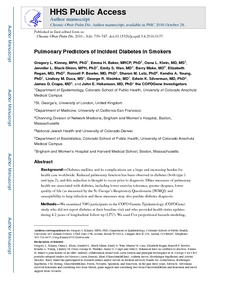Kinney, GL;
Baker, EH;
Klein, OL;
Black-Shinn, JL;
Wan, ES;
Make, B;
Regan, E;
Bowler, RP;
Lutz, SM;
Young, KA;
et al.
Kinney, GL; Baker, EH; Klein, OL; Black-Shinn, JL; Wan, ES; Make, B; Regan, E; Bowler, RP; Lutz, SM; Young, KA; Duca, LM; Washko, GR; Silverman, EK; Crapo, JD; Hokanson, JE
(2016)
Pulmonary Predictors of Incident Diabetes in Smokers.
Chronic Obstr Pulm Dis, 3 (4).
pp. 739-747.
https://doi.org/10.15326/jcopdf.3.4.2016.0137
SGUL Authors: Baker, Emma Harriet
![[img]](https://openaccess.sgul.ac.uk/108386/1.hassmallThumbnailVersion/final%20paper.pdf)  Preview |
|
PDF
Accepted Version
Available under License ["licenses_description_publisher" not defined].
Download (429kB)
| Preview
|
Abstract
BACKGROUND: Diabetes mellitus and its complications are a large and increasing burden for health care worldwide. Reduced pulmonary function has been observed in diabetes (both type 1 and type 2), and this reduction is thought to occur prior to diagnosis. Other measures of pulmonary health are associated with diabetes, including lower exercise tolerance, greater dyspnea, lower quality of life (as measured by the St. George's Respiratory Questionaire [SGRQ]) and susceptibility to lung infection and these measures may also predate diabetes diagnosis. METHODS: We examined 7080 participants in the COPD Genetic Epidemiology (COPDGene) study who did not report diabetes at their baseline visit and who provided health status updates during 4.2 years of longitudinal follow-up (LFU). We used Cox proportional hazards modeling, censoring participants at final LFU contact, reported mortality or report of incident diabetes to model predictors of diabetes. These models were constructed using known risk factors as well as proposed markers related to pulmonary health, forced expiratory volume in 1 second (FEV1), forced vital capacity (FVC), FEV1/FVC, respiratory exacerbations (RE), 6-minute walk distance (6MWD), pulmonary associated quality of life (as measured by the SGRQ), corticosteroid use, chronic bronchitis and dyspnea. RESULTS: Over 21,519 person years of follow-up, 392 of 7080 participants reported incident diabetes which was associated with expected predictors; increased body mass index (BMI), high blood pressure, high cholesterol and current smoking status. Age, gender and accumulated smoking exposure were not associated with incident diabetes. Additionally, preserved ratio with impaired spirometry (PRISm) pattern pulmonary function, reduced 6MWD and any report of serious pulmonary events were associated with incident diabetes. CONCLUSIONS: This cluster of pulmonary indicators may aid clinicians in identifying and treating patients with pre- or undiagnosed diabetes.
Statistics
Item downloaded times since 12 Jun 2017.
Actions (login required)
 |
Edit Item |



